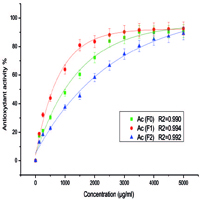Total phenolic and flavonoids contents and in vitro evaluation of antioxidant activity of several Calendula officinalis (Marigold) extracts

Accepted: April 22, 2021
Appendix: 112
All claims expressed in this article are solely those of the authors and do not necessarily represent those of their affiliated organizations, or those of the publisher, the editors and the reviewers. Any product that may be evaluated in this article or claim that may be made by its manufacturer is not guaranteed or endorsed by the publisher.
Authors
The search for natural antioxidants to replace synthetic antioxidants is one of humanity’s health priorities. Medicinal and Aromatic Plants (MAP) contain phenolic compounds that act as natural antioxidants. The aim of this work is to study total phenols and flavonoids contents and evaluate the antioxidant power of various extracts of Calendula officinalis. Extracts were prepared in two steps: hot solid-liquid extraction, by Soxhlet and from the plant powder using a solvent (Methanol/water 70/30, Acetone/water 70/30) followed by a liquid-liquid extraction by splitting the obtained extract by two increasingly polarized solvents (Ethyl acetate and Butanol). Total phenols and flavonoids were evaluated using gallic acid and quercetin as standards, respectively. The antioxidant activity of extracts was determined by DPPH (2,2-diphényl 1-picrylhydrazyle) free radical reduction method. The two crude fractions of Methanol and Acetone presented the highest levels of total phenols (7,58±0,38 mg GAE/g dm and 6,80±0,34 mg GAE/g dm respectively), and flavonoids (7,37±0,37 mg QE/g dm and 7,93±0,40 mg QE/g dm respectively). Ethyl acetate fractions showed a high antioxidant activity. This study demonstrated that extracts from Calendula officinalis flowers present a promising source of natural antioxidant.
How to Cite
PAGEPress has chosen to apply the Creative Commons Attribution NonCommercial 4.0 International License (CC BY-NC 4.0) to all manuscripts to be published.

 https://doi.org/10.4081/jbr.2021.9680
https://doi.org/10.4081/jbr.2021.9680



